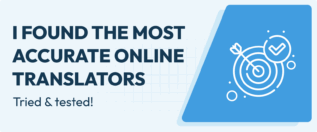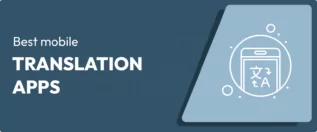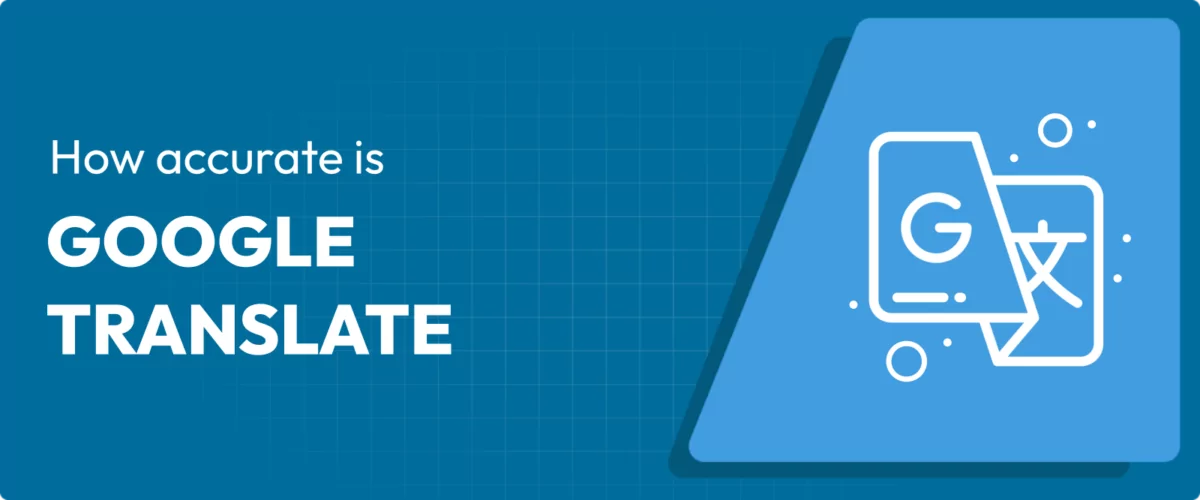
In this post
Is Google Translate accurate?
If you’re using Google Translate for your translations, you’ll probably be wondering if Google Translate is correct and whether you can trust Google Translate accuracy for your use case.
Well, the short answer is this:
Yes, Google Translate is very accurate for the most part. In some cases, it’s 94%+ accurate!
In fact, it’s one of the top-rated translation tools when it comes to translation accuracy, though the exact accuracy will depend on the language pairs that you’ve chosen.
With that being said, it’s not 100% perfect, and there actually is a more accurate translation service that you might want to consider in some situations.
However, there are tradeoffs with that alternative, which is why Google Translate is probably still going to be the best option for most people.
Want more details about Google Translate accuracy? Keep reading our full post to learn all of the gory details.
How Does Google Translate Work?
Before we talk about how reliable Google Translate is, let’s quickly run over some basic details on how Google Translate actually works behind the scenes.
Why is this important when we’re talking about Google Translate accuracy?
Well, the evolution of the way that Google Translate performs its translations will actually give you some insight into its accuracy and why Google Translate has gotten a lot better since late 2016.
Beyond the backend translation, it’s also important to understand the different options that you, as a user, have for using Google Translate.
The Old Google Translate Approach (Before 2016)
In the past, Google Translate used a fairly simple translation model, which is why its accuracy struggled in the past.
Here’s how that old system worked:
- You entered a text to translate;
- Google Translate searched its huge database to find human-translated documents in the selected language pair;
- Google Translate detected the most frequently used version of the word or phrase from the text and supplied that as the translation for that word/phrase;
- If needed, Google Translate repeated this for each word/phrase in the translation text to fully translate the content.
This model is called statistical machine translation, or SMT for short.
While that approach was ok for single words or short phrases, it caused a lot of issues with longer, more complex sentences because Google Translate wasn’t able to accurately assess the context of the sentence as a whole.
Instead, it essentially translated word-for-word. This is why pre-2016 translations often felt robotic and didn’t sound natural.
Another issue is that this old system relied on using English as an intermediary for each translation.
For example, let’s say you translated text from Spanish to German. While you may have selected just those two languages, here’s how Google Translate actually worked on the backend:
- First, it translated the Spanish text into English;
- Then it translated the English version of the Spanish text into German.
This extra step in the middle provided further opportunities for issues to arise and added to the “robotic” feel of some translations.
Google Translate ditched this old system in 2016, though, opting for a new algorithm that opened the door for much better accuracy.
The New Google Translate Approach (After 2016)
In late 2016, Google Translate moved to a new machine learning system called Google Neural Machine Translation, or GNMT for short.
There are a lot of technical details behind the scenes of how GNMT works. But the basic idea is this:
Rather than translating sentences word-by-word (or phrase-by-phrase) like the old system, the GNMT approach translates the meaning of entire sentences at a time.
By looking at the meaning of the sentence as a whole rather than just the individual words, Google Translate is able to generate more accurate, natural-sounding translations. In fact, Google claims that this approach “reduce[d] translation errors by more than 55%-85% on several major language pairs”.
Here’s an image comparing human translation vs GNMT vs Google’s older approach (PBMT) (these results are from 2016):
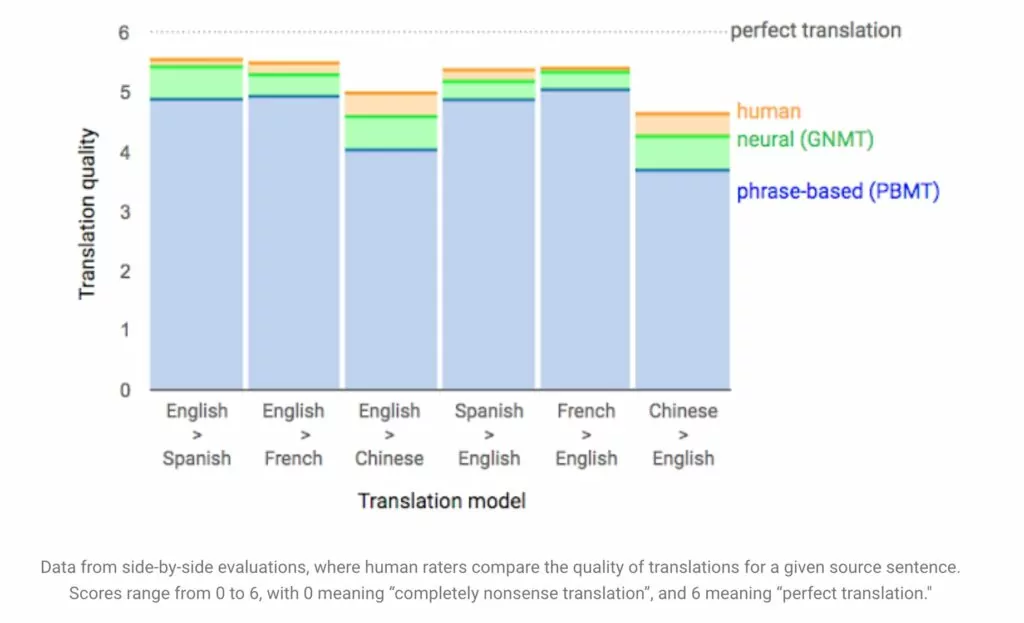
And here’s an example of a sentence translated using the different methods:

The new GNMT approach also allows for “zero-shot translation”, which means that Google Translate can translate directly between languages rather than relying on English as an intermediary.
For example, it can go straight from Spanish to German, rather than Spanish → English → German.
Overall, switching to this new translation approach in late 2016 allowed Google Translate to achieve huge leaps in accuracy, while also creating more natural translations.
How to Use Google Translate for Translations
So that’s how the backend translation works. Now, let’s take a quick look at the experience for users.
To use Google Translate to translate content as a user, you have several options.
For personal use, you can use the Google Translate website or mobile apps. These tools let you translate text, documents, other websites, and even text in images.
Beyond these consumer-facing tools, Google Translate also offers an API, which lets you easily use Google Translate to fully translate your own website or app.
For example, if you want to create a multilingual website, you can use Google Translate to generate all of your translations.
However, in order to benefit from the API, you’ll need a way for your website to interact with the API. If you’ve built your website with WordPress, you can easily set this up using the TranslatePress plugin – more on that later!
Is Google Translate Accurate?
Ok, so now you know how Google Translate works. Next question – is Google Translate correct when it translates content?
Well, there’s one important caveat here:
Google Translate supports over 130+ different languages, which is one of the broadest language support selections that you’ll find in a WordPress translation tool.
Because it supports so many different languages, there’s no single accuracy rate. Instead, the accuracy of Google Translate will depend on the specific language pairs that you’ve chosen.
For example, translating from English to Spanish has a very high accuracy rate because it’s such a popular and frequently used language pairing. In fact, the Google Translate accuracy rate for English/Spanish is generally over 90%.
In contrast, translating from English to Armenian has a lower accuracy rate because this pair is not as popular. Some studies show the Google Translate accuracy rate for English/Armenian to only be around 55%, which is a big difference.
To get these numbers, we can turn to a number of peer-reviewed studies that have been published about Google Translate’s reliability.
Typically, these studies are focused on specific use cases, such as using Google Translate in medical situations. However, the basic accuracy trends should hold true for other use cases.
2019 Study from UCLA and Memorial Sloan Kettering Cancer Center
One of the most recent studies of Google Translate accuracy is a 2019 study from UCLA and Memorial Sloan Kettering Cancer Center.
This study looked at using Google Translate for medical instructions, which is a tough test of accuracy because inaccurate translations could actually lead to medical harm.
The study analyzed a number of different languages and found accurate rates ranging from 94% to 55% depending on the language.
All of the translations started in English.
Here are the accuracy numbers by the destination language:
- Spanish – 94% accurate
- Tagalog – 90% accurate
- Korean – 82.5% accurate
- Chinese – 81.7% accurate
- Farsi – 67.5% accurate
- Armenian – 55% accurate
The overall accuracy rate for all of the translations that the study looked at was 82.5%.
Remember – this is a very strict test of accuracy where any ambiguity in the translation was viewed as a failure because it dealt with medical instructions. For less important use cases, an “inaccurate” translation might still be good enough.
2018 Study From San Francisco
For another data point, we can also look at a late 2018 study from the University of California, San Francisco, and San Francisco General Hospital.
As with the previous study, this study is also focused on using Google Translate in medical situations where inaccurate translations could cause actual harm.
However, this study only looked at translating content from English into Spanish and Chinese.
Here are the overall accuracy rates:
- Spanish – 92% accurate
- Chinese – 81% accurate
Is There a More Accurate Translation Than Google Translate?
As we mentioned above, Google Translate is not perfect, but it’s still one of the more reliable and accurate translation services that you’ll find.
It typically beats out other popular services such as Microsoft Translator and Amazon Translate, which is why it’s grown to be so popular.
When you’re talking about translation accuracy, there are multiple factors to consider.
Most notably, there’s a difference between a translation being technically accurate and a translation sounding natural (i.e. how humans actually write and speak).
When it comes to creating natural-sounding translations, there is one translation service that does regularly rank above Google Translate – DeepL.
DeepL generally does a better job at preserving context and handling colloquialisms and other local slang, which is why a lot of people prefer using DeepL over Google Translate.
DeepL vs Google Translate Accuracy
We have two data points for comparing DeepL vs Google Translate accuracy.
First, there’s a study commissioned by DeepL.
While this might give you pause, this study generally matches independent analyses and opinions.
This study asked independent translation professionals to rate the quality of translations from four different machine translation services:
- DeepL
- Google Translate
- Amazon Translate
- Microsoft Translate
More specifically, they asked those professionals to choose the best translation in situations where one service was better than the others.
This study is not rating overall accuracy because it doesn’t capture situations where all of the translations were equally good. Instead, it’s just capturing situations where one translation was noticeably better than the others, which could be because it sounded more natural, was more accurate, and so on.
In this study, DeepL consistently ranked first for all of the language pairs, while Google Translate consistently ranked second.
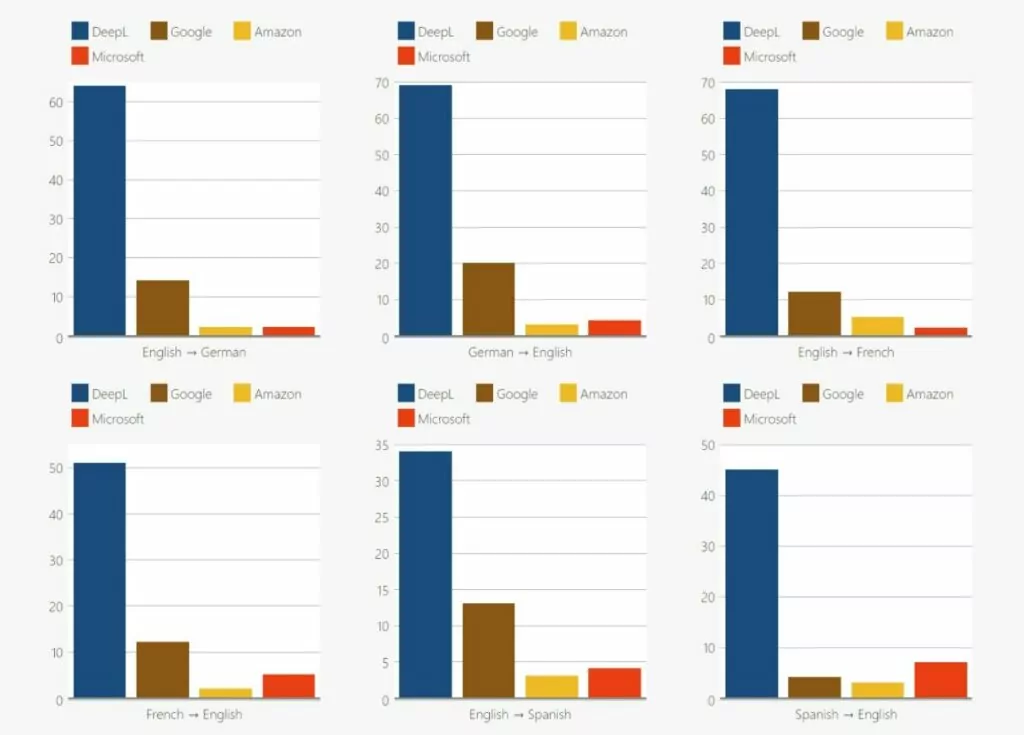
To add to this data, Gigazine, a Japanese blog, compared DeepL vs Google Translate accuracy for Japanese translations and found that DeepL’s translations were more accurate.
Basically, while Google Translate is quite accurate, DeepL can be even more accurate for the languages that it supports.
Drawbacks of DeepL
There are two big caveats with DeepL that might still make Google Translate the better option:
First, it only has a limited selection of support languages, mainly focused on European languages (though it does support Chinese, Japanese, and Korean).
While Google Translate supports 130+ languages, DeepL only supports 30+ languages.
If DeepL supports all of the language pairs that you need, that’s great! But if it doesn’t, Google Translate will still generally be the most accurate translation service for your needs.
Second, the DeepL translation API service is a little more expensive than the Google Translate API, which can be an important consideration if you’re planning to use it to translate your website or app.
For a deeper look at these two services, you can read our full DeepL vs Google Translate comparison. We also have a dedicated DeepL translator review.
A Better Alternative?
You might have guessed it but an even better alternative would be a combination of the two, depending on the situation. But how is that possible?
Fortunately, there is at least one solution that makes this possible for you. TranslatePress AI is a smart AI translator that combines the power of leading machine translation engines (such as DeepL and Google Translate) and chooses the best one for each language pair or particular situation.
This ensures the best accuracy you can get with machine translation. But I will get back to how you can use it in the next section.
How to Translate Your Website With Google Translate (or DeepL)
If you just want to translate a sentence or some paragraphs of text, all you need to do is head to the Google Translate or DeepL websites and paste in the text.
However, if you have your own website and you want to translate its content to create a multilingual website, you’ll need to rely on these services’ API offerings.
Essentially, the API lets you connect your website to the translation service to automatically translate all of your website’s existing content, as well as any new content that you add in the future.
If you’ve built your website with WordPress, the easiest way to make use of these APIs is via the TranslatePress plugin.
If you want a detailed look, check out our full guides on how to create a multilingual WordPress website or how to automatically translate WordPress.
If you just want the highlights, here’s a quick version of how to use TranslatePress to translate your website using Google Translate or DeepL.
TranslatePress Multilingual
1. Install the TranslatePress Plugin and Choose Languages
To get started, you’ll want to install the free TranslatePress plugin on your site. It’s listed at WordPress.org, so you can install it like any other plugin.
Then, head to Settings → TranslatePress in your WordPress dashboard to choose the languages that you want to use on your site. The free version of TranslatePress lets you add one new language, while the premium version supports unlimited new languages.
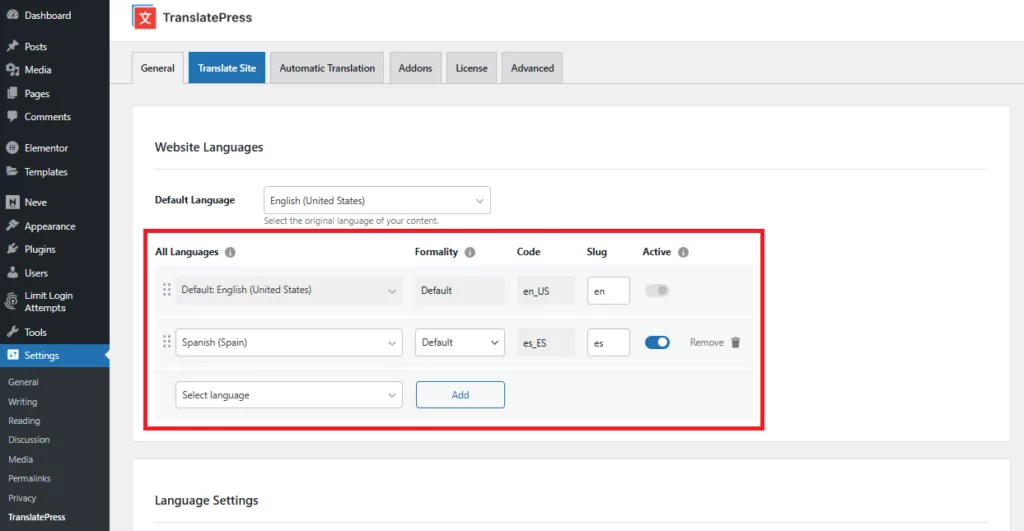
2. Set Up Automatic Translation
Once you’ve chosen your site’s languages, head to the Automatic Translation tab in the TranslatePress settings area to configure the Google Translate integration.
The easiest way to integrate Google Translate along with other top neural machine translation engines to ensure the best translations is through TranslatePress AI.
All you have to do is activate your TranslatePress license, add the languages you want on your site, and activate Automatic Translation.
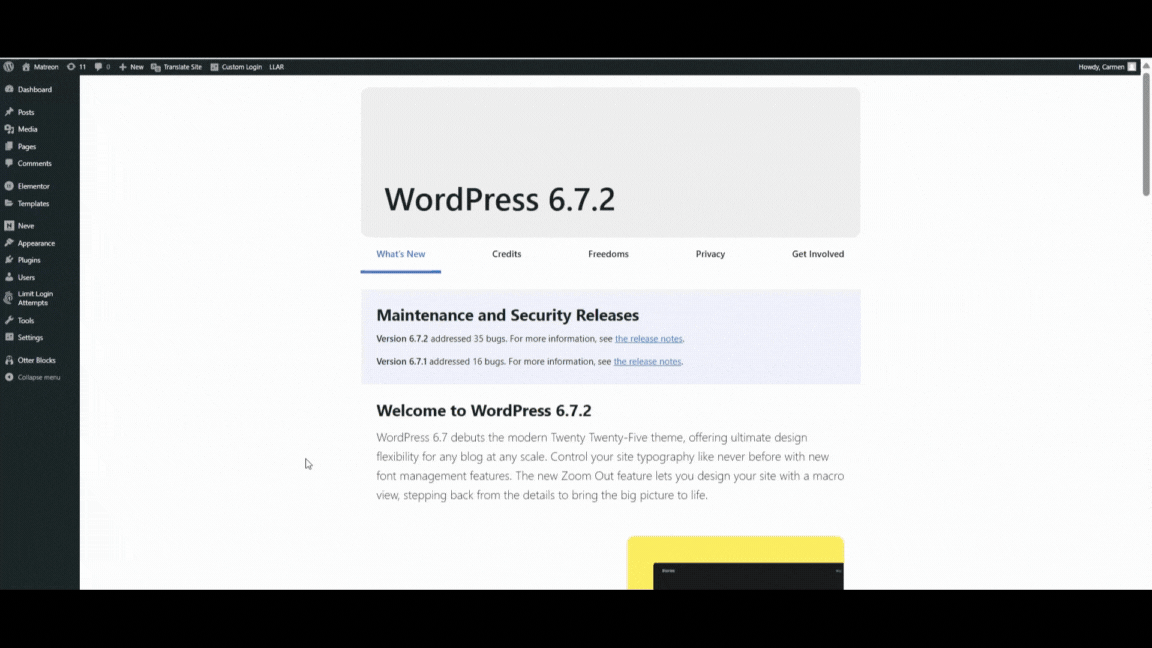
Now, when you visit your website from the front end and switch to your additional languages, you’ll be able to see your website already translated.
Note: This feature is only available with premium licenses of TranslatePress, which include a set number of AI words you can use with TrabnslatePress AI. Once your included words run out, you can always get more.
If you want to save some money, you can still go with the free version of TranslatePress which lets you add the Google Translate API to your site. This will take a bit more setup on your part, but it will cost you less.
So first you’ll need to generate a Google Translate API key by following these instructions. Then, you can add that API key to the TranslatePress settings to enable automatic translation:
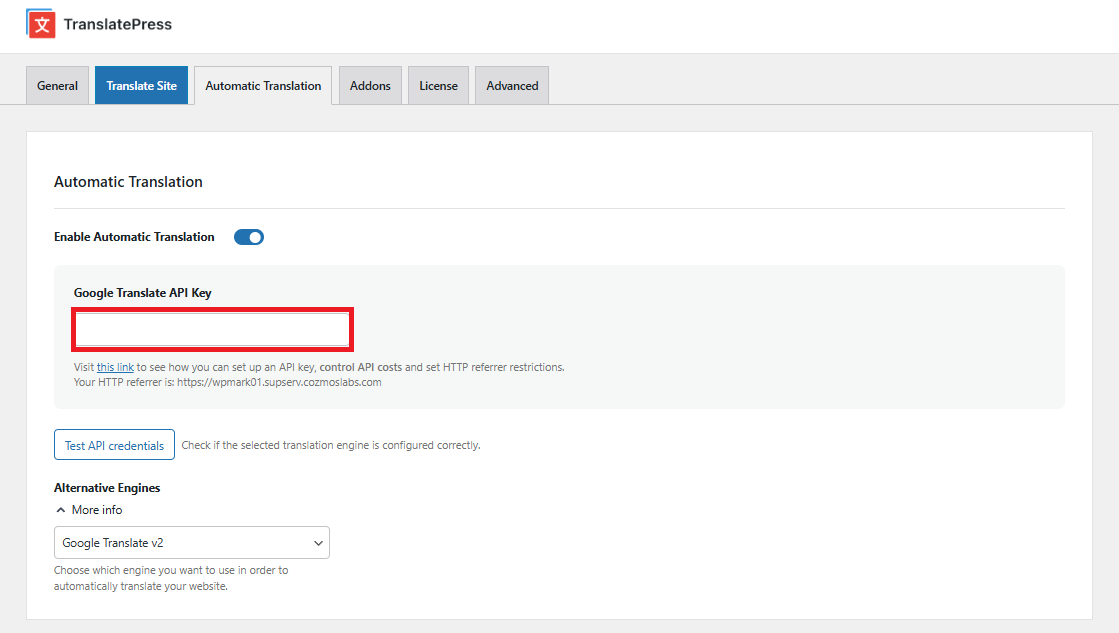
Alternatively, you can also use DeepL for automatic translation if you prefer. However, in order to access the DeepL integration, you’ll need to purchase at least the TranslatePress Business license.
3. Refine Translations Using Visual Editor
At this point, TranslatePress will have fully translated your site’s content using TranslatePress AI, or a Google Translate (or DeepL) API key.
However, if you want to, you also have the option to manually edit/refine those translations using the visual TranslatePress translation editor.
To launch the editor, open the page that you want to edit on the front end of your site and then click the Translate Page option on the WordPress toolbar.
Then, here’s how to edit any one of the automatic translations:
- Hover over the text that you want to translate/edit;
- Click on the pencil icon to open that translation in the sidebar;
- Use the sidebar to edit the translated text as needed.

You can use this same point-and-click approach to edit the translations for any content on your site, no matter where it comes from.
Again, for a more detailed look, check out our full guides on how to make a multilingual website or how to automatically translate WordPress.
Final Thoughts on Google Translate Accuracy
So – is Google Translate accurate?
In general, Google Translate has very high accuracy, especially for popular languages such as Spanish and Chinese.
While Google Translate did have some issues in the past, its 2016 shift to the Google Neural Machine Translation approach has led to much more accurate translations by translating the meaning of entire sentences instead of individual words.
When compared to other translation services, Google Translate generally is more accurate.
There is one exception, though – DeepL. DeepL is regularly rated as offering even more accurate translations than Google Translate.
However, DeepL has a much more limited selection of languages, so it may or may not fit your needs. It’s also more expensive than Google Translate if you need API usage.
If you want to learn more about these two services, you can read our full DeepL vs Google Translate comparison.
We also have a post with some of the best Google Translate alternatives that might be worth considering. Excluding DeepL, these services can usually offer cost savings over Google Translate, but not necessarily accuracy improvements.
Finally, if you’re satisfied with Google Translate’s accuracy and you want to use it to translate your WordPress site, you can easily set things up using the TranslatePress plugin.
TranslatePress Multilingual
Still have any questions about how accurate Google Translate is? Let us know in the comments!
If you found this post helpful, please check out our YouTube channel, where we constantly upload short & easy-to-follow video tutorials. You can also follow us on Facebook and Twitter to be the first to know each time we post.

